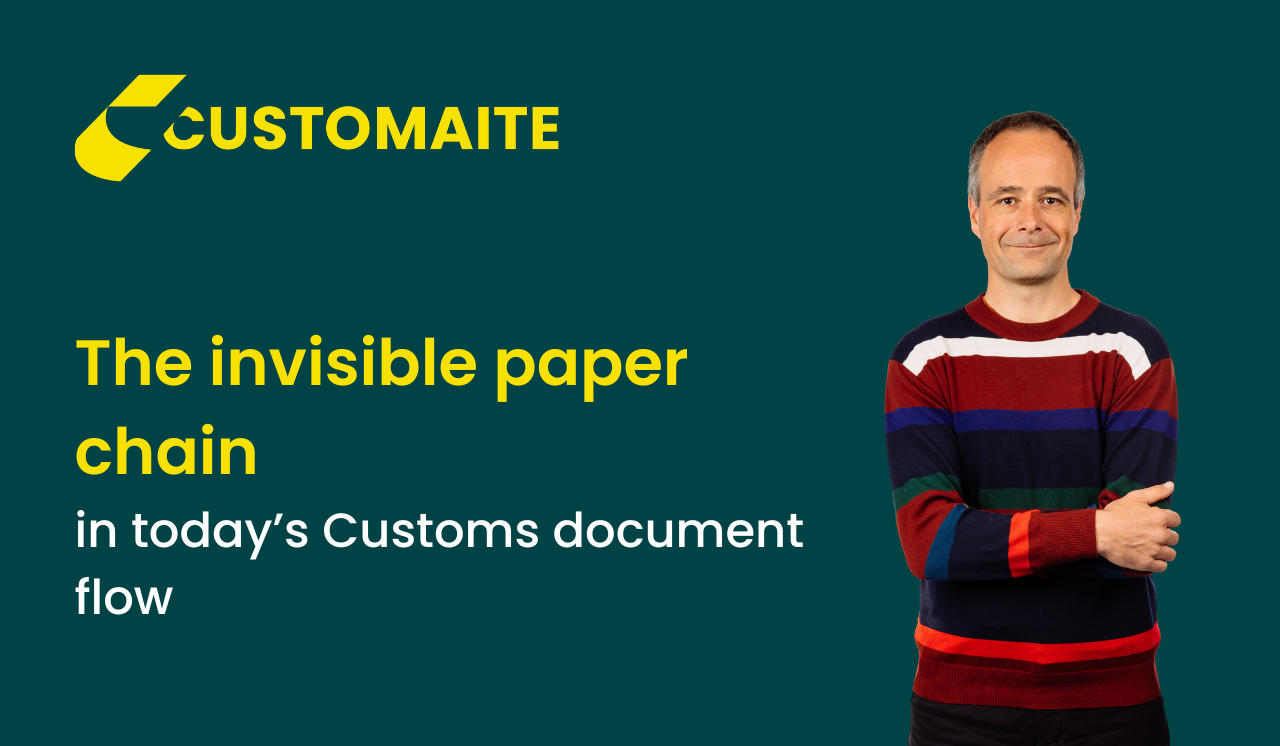As in other sectors, the logistics sector has benefited from digitization in recent years, allowing a smoother flow of goods across the globe. These advancements have promised, and to some extent also delivered, efficiency and convenience. However, a more ‘inconvenient truth’ today is that a considerable volume of critical information still circulates in the form of non-standardized documents sent via email. Today, new developments in Artificial Intelligence are proving promising in enabling the data extraction of these unstructured documents and scans to finally fully break the paper chain.
The logistics sector plays a critical role in ensuring the smooth flow of goods around the globe. However, a smooth flow of goods through the supply chain is only possible if the information regarding these goods also flows smoothly between the various parties in the chain, making digitalization an absolute necessity. This applies in particular to Customs processes, as declaring goods to Customs requires qualitative information from many different parties that is easily available.
In recent years, the world has witnessed remarkable progress in digitization, revolutionizing the way data is exchanged across industries. The logistics sector is no exception to this: from EDI (Electronic Data Interchange) to electronic document standards and comprehensive data sharing platforms using APIs (Application Programming Interfaces), these advancements have promised, and to some extent also delivered, efficiency and convenience.
However, despite these strides, a considerable volume of critical information still circulates in the form of non-standardized documents sent via email. Furthermore, and to make things worse, a large portion of documents that might seem digital at first glance (generally in the ubiquitous PDF format) often conceal a surprising secret – they are mere scans of paper documents.
A peculiar workflow that’s difficult to correct
While interacting with Customs brokers or Customs department staff within a company, I often observed this peculiar workflow: it involves the printing of information that was digitally available at some point in time, on paper, followed by scanning it to convert it back into a “digital” format.
The information trapped within these scans cannot be readily copied or extracted, forcing Customs declarants to resort to the tedious and error-prone task of manually retrieving information: you will see them scouring these documents they have printed out and retyping the required information into their Customs declaration (or any other) software. Even if they have readable non-standardized documents, such as Word or Excel documents, the result is similar. It may be possible to copy the information in the documents, but the documents still have to be searched and processed manually.
This – seemingly – unbreakable paper chain poses significant challenges for companies and Customs administrations alike, resulting in increased costs, inefficiencies, and elevated risks. Enter Artificial Intelligence (AI), a potent force poised to shatter this paper chain and address the myriad challenges linked to paper document processing.
The paper jam
To truly appreciate the potential of AI in this context, we must first grasp the depth of the problem. For businesses including Customs brokers, freight forwarders, importers and exporters, the reliance on paper documents has several costly implications. One major concern is the escalation of operational expenses due to increased costs. These result from the inefficiencies and errors that arise when manual data retrieval and input are required for Customs declarations.
Another challenge is the scarcity of qualified declarants. The complexity of navigating through this paper-driven maze necessitates a specialized skill set, making it difficult for companies to find and retain individuals with the necessary expertise. Moreover, the repercussions extend to supply chains, as errors or delays in Customs declarations can trigger a ripple effect, disrupting logistics operations and leading to financial losses and operational headaches.
From the perspective of Customs administrations, the challenges are equally daunting. The surge in workload is a prominent issue, as errors in declarations demand additional scrutiny and manual intervention. This places an increased burden on Customs administrations. Furthermore, there is the looming risk of undetected errors concealed within paper documents. These hidden pitfalls pose a substantial threat, potentially compromising security measures and revenue collection.
Unlocking opportunities with AI
Artificial Intelligence (AI) offers a transformative solution to these document-related challenges which, as we have established, will not be going away anytime soon. The heart of the matter lies in AI’s ability to automatically extract and interpret information from documents. By leveraging AI technologies, we can reimagine document processing, reducing errors and inefficiencies while enhancing speed and accuracy.
AI-driven document processing involves a spectrum of techniques and approaches, ranging from basic Optical Character Recognition (OCR) to advanced Intelligent Document Processing (IDP) techniques. Let’s offer a brief description of what they are capable of.
The OCR technology has a longstanding presence, but its limitations lie in its inability to impart meaning to the extracted text. OCR, in its traditional form, excels at recognizing and converting printed or handwritten text within images or scanned documents into machine-readable text. However, it does not inherently understand the context or significance of the text it extracts. Typically, OCR is paired with Robotic Process Automation (RPA) technology, wherein meaning is imparted by explicitly instructing the algorithm where to locate specific information within a document. This is achieved by creating templates for every different document with its own specific layout or structure, but this approach lacks scalability and is error-prone.
On the horizon is Intelligent Document Processing (IDP), a paradigm that takes AI a step further. Here, Natural Language Processing (NLP) algorithms, including Large Language Models (LLMs) like ChatGPT, come into play, elevating the understanding of context and meaning within documents to a new level. Unlike traditional OCR, NLP algorithms do not rely on rigid templates. They also require instructing the algorithm where to find information within documents, but they possess the remarkable ability to generalize to new document structures they have never encountered before, alleviating the need to construct a new template for every new document type you want to process.
This makes NLP-based solutions more scalable and adaptable to diverse document types and formats. Moreover, pretrained models are available, typically trained on vast amounts of logistics documents, and specifically aimed at extracting and interpreting information that is relevant within the logistics context. These pretrained NLP models offer powerful language understanding capabilities and facilitate the extraction of information from logistics documents more efficiently than ever before.
Don't take away my paper!
Despite the immense promise of AI, challenges abound in implementing this technology effectively, each demanding a thoughtful approach. The first hurdle to surmount is the recognition that AI is not infallible and may never achieve perfection. Mistakes can occur, and there might be instances where information is missing. This means that possibly a lot of time is spent (lost) searching for missing information and correcting inaccuracies, to the extent that the initial time savings from AI implementation could be compromised.
The second challenge revolves around understanding that AI model outputs do not equate to outcomes. While these AI models generate meaningful information, this information must undergo further processing downstream to culminate in an actual Customs declaration.
The third obstacle relates to the black-box nature of AI models. Employees within companies often harbor reservations or skepticism towards this technology. On the one hand, they might lack faith in AI’s capabilities, while on the other, they may fear its implications. Such apprehension can lead to resistance and reluctance to adopt and utilize AI technology effectively within their workflows.
Because of these hurdles, there is a risk that people revert to printing documents, effectively bringing us back to square one. In this scenario, the paper chain remains unbroken, and the benefits of AI implementation go unrealized. Overcoming these challenges is crucial to ensuring that AI truly transforms Customs document processing and breaks free from the shackles of traditional paper-based workflows.
Breaking the paper chain with human-assisted AI
To harness the full potential of AI in this context, a specific approach emerges as a compelling solution – Human-Assisted AI. This approach recognizes that while AI can perform tasks autonomously, there are areas where human expertise remains indispensable.
A Software as a Service (SaaS) solution exists which can automate and optimize the Customs declaration processes that still involve unstructured documents and scans. It embodies the vision of Human-Assisted AI by offering:
-
A rich user interface that replicates the declarant’s familiar (paper) workspace, allowing efficient but fully digital means to validate, assess and, if necessary, correct the extracted information. The idea here is to make the transition to digital seamless and user-friendly.
-
Integration into declarants’ operational processes, providing a guided workflow that simplifies Customs declarations and produces accurate declaration proposals.
-
Seamless integration into the existing IT landscape, like declaration software, transport or warehouse management systems, etc., and enrichment of the declaration proposals with data from those systems.
-
Effective change management support, empowering declarants to embrace the technology and leverage it to its full potential.
Measuring the impact
To illustrate the effectiveness of the Human-Assisted AI approach and the transformative impact of such software, a comprehensive measurement was conducted, comparing the traditional manual process with the newly implemented automated process.
The performance across five distinct flows within the forwarder’s operations was meticulously evaluated. These flows encompassed a wide array of Customs declaration tasks, each with its unique complexities. The goal was to understand how the software could enhance efficiency and accuracy while saving valuable time. In the case of the automated process, time savings ranged between 50% and an astounding 75%. For instance, a task that previously consumed 40 minutes of handling time was now accomplished in just 10 minutes. This substantial reduction in processing time translated into significant operational efficiencies.
However, the impact extended far beyond time savings alone. The implementation of the software led to a remarkable increase in the quality of Customs declarations. With AI handling the data extraction, the risk of human errors was substantially diminished, ensuring that declarations were consistently accurate and compliant. Moreover, the time freed up by the expedited process allowed declarants to shift their focus.
Instead of laboriously retyping information, they were now empowered to channel their expertise towards more meaningful tasks related to Customs matters. In essence, the software not only revolutionized the speed and accuracy of Customs declaration processes, but also unleashed the potential of declarants to elevate their role as Customs experts, thereby enhancing the overall service quality and customer satisfaction.
This use case serves as a compelling testament to the power of Human-Assisted AI and its transformative impact in breaking the paper chain and redefining Customs declaration processes for the better.
------
This article was originally posted on the WCO magazine website. You can read the article here: https://mag.wcoomd.org/magazine/wco-news-102-issue-3-2023/the-invisible-paper-chain/
------
Want to see our human-focused AI in action ? Book a demo.






